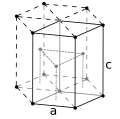Revision as of 17:13, 16 December 2020 by imported>Monkbot
[[Category:Template:Pagetype with short description]]
Rutherfordium, 104 Rutherfordium Pronunciation (Template:Respell ) Mass number [267] Rutherfordium in the periodic table
Atomic number (Z ) 104 Group group 4 Period period 7 Block d-block Electron configuration [Rn ] 5f14 6d2 7s2 [1] [2] Electrons per shell 2, 8, 18, 32, 32, 10, 2 Physical properties Phase at STP solid (predicted) [1] [2] Melting point 2400 K (2100 °C, 3800 °F) (predicted) [1] [2] Boiling point 5800 K (5500 °C, 9900 °F) (predicted) [1] [2] Density (near r.t. ) 23.2 g/cm3 (predicted) [1] [2] [3] Atomic properties Oxidation states (+2), (+3 +4 [1] [2] [3] prediction ) Ionization energies 1st: 580 kJ/mol 2nd: 1390 kJ/mol 3rd: 2300 kJ/mol (more ) (all but first estimated) [2] Atomic radius empirical: 150 pm (estimated) [2] Covalent radius 157 pm (estimated) [1] Other properties Natural occurrence synthetic Crystal structure hexagonal close-packed (hcp)(predicted) [4] CAS Number 53850-36-5 History Naming after Ernest Rutherford Discovery Joint Institute for Nuclear Research and Lawrence Berkeley National Laboratory (1964, 1969) Main isotopes of rutherfordium
Category: Rutherfordium references
[[Category:Infobox templates|Template:Remove first word ]]
References These references will appear in the article, but this list appears only on this page.
↑ Jump up to: 1.01.1 1.2 1.3 1.4 1.5 1.6 "Rutherfordium" . Royal Chemical Society. Retrieved 2019-09-21 .↑ Jump up to: 2.02.1 2.2 2.3 2.4 2.5 2.6 2.7 Hoffman, Darleane C.; Lee, Diana M.; Pershina, Valeria (2006). "Transactinides and the future elements". In Morss; Edelstein, Norman M.; Fuger, Jean (eds.). The Chemistry of the Actinide and Transactinide Elements (3rd ed.). Dordrecht, The Netherlands: Springer Science+Business Media . ISBN 978-1-4020-3555-5 ↑ Jump up to: 3.03.1 Fricke, Burkhard (1975). "Superheavy elements: a prediction of their chemical and physical properties" . Recent Impact of Physics on Inorganic Chemistry . Structure and Bonding. 21 : 89–144. doi :10.1007/BFb0116498 . ISBN 978-3-540-07109-9 . Retrieved 4 October 2013 . ↑ Östlin, A.; Vitos, L. (2011). "First-principles calculation of the structural stability of 6d transition metals". Physical Review B . 84 (11): 113104. Bibcode :2011PhRvB..84k3104O . doi :10.1103/PhysRevB.84.113104 . ↑ Jump up to: 5.05.1 5.2 Sonzogni, Alejandro. "Interactive Chart of Nuclides" . National Nuclear Data Center: Brookhaven National Laboratory. Retrieved 2008-06-06 . ↑ Utyonkov, V. K.; Brewer, N. T.; Oganessian, Yu. Ts.; Rykaczewski, K. P.; Abdullin, F. Sh.; Dimitriev, S. N.; Grzywacz, R. K.; Itkis, M. G.; Miernik, K.; Polyakov, A. N.; Roberto, J. B.; Sagaidak, R. N.; Shirokovsky, I. V.; Shumeiko, M. V.; Tsyganov, Yu. S.; Voinov, A. A.; Subbotin, V. G.; Sukhov, A. M.; Karpov, A. V.; Popeko, A. G.; Sabel'nikov, A. V.; Svirikhin, A. I.; Vostokin, G. K.; Hamilton, J. H.; Kovrinzhykh, N. D.; Schlattauer, L.; Stoyer, M. A.; Gan, Z.; Huang, W. X.; Ma, L. (30 January 2018). "Neutron-deficient superheavy nuclei obtained in the 240 Pu+48 Ca reaction". Physical Review C . 97 (14320): 014320. Bibcode :2018PhRvC..97a4320U . doi :10.1103/PhysRevC.97.014320 . Lua error: Internal error: The interpreter has terminated with signal "24".
